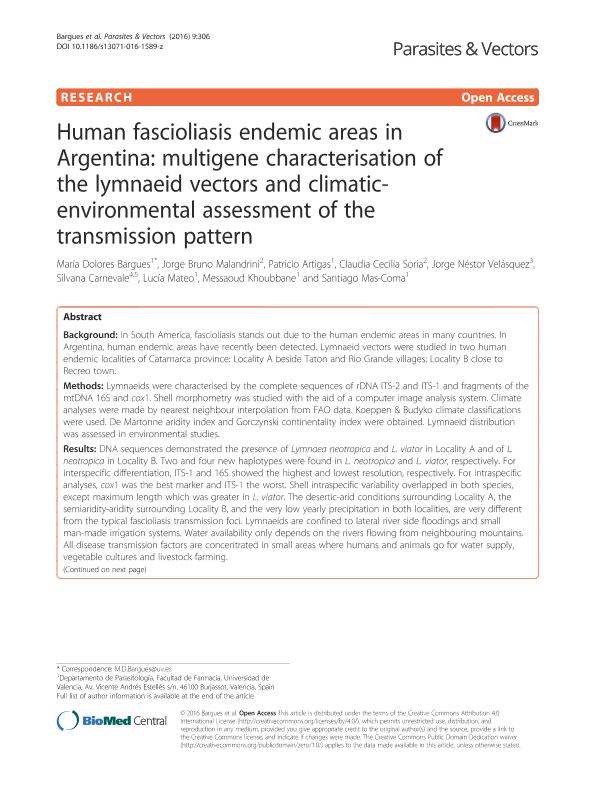Mostrar el registro sencillo del ítem
dc.contributor.author
Bargues, María Dolores
dc.contributor.author
Malandrini, Jorge Bruno

dc.contributor.author
Artigas, Patricio
dc.contributor.author
Soria, Claudia Cecilia
dc.contributor.author
Velásquez, Jorge Néstor

dc.contributor.author
Carnevale, Silvana

dc.contributor.author
Mateo, Lucía
dc.contributor.author
Khoubbane, Messaoud
dc.contributor.author
Mas-Coma, Santiago

dc.date.available
2018-05-14T20:08:06Z
dc.date.issued
2016-05
dc.identifier.citation
Bargues, María Dolores; Malandrini, Jorge Bruno; Artigas, Patricio; Soria, Claudia Cecilia; Velásquez, Jorge Néstor; et al.; Human fascioliasis endemic areas in Argentina: multigene characterisation of the lymnaeid vectors and climatic-environmental assessment of the transmission pattern; BioMed Central; Parasites and Vectors; 9; 1; 5-2016; 1-20
dc.identifier.issn
1756-3305
dc.identifier.uri
http://hdl.handle.net/11336/45145
dc.description.abstract
Background: In South America, fascioliasis stands out due to the human endemic areas in many countries. In Argentina, human endemic areas have recently been detected. Lymnaeid vectors were studied in two human endemic localities of Catamarca province: Locality A beside Taton and Rio Grande villages; Locality B close to Recreo town. Methods: Lymnaeids were characterised by the complete sequences of rDNA ITS-2 and ITS-1 and fragments of the mtDNA 16S and cox1. Shell morphometry was studied with the aid of a computer image analysis system. Climate analyses were made by nearest neighbour interpolation from FAO data. Koeppen & Budyko climate classifications were used. De Martonne aridity index and Gorczynski continentality index were obtained. Lymnaeid distribution was assessed in environmental studies. Results: DNA sequences demonstrated the presence of Lymnaea neotropica and L. viator in Locality A and of L. neotropica in Locality B. Two and four new haplotypes were found in L. neotropica and L. viator, respectively. For interspecific differentiation, ITS-1 and 16S showed the highest and lowest resolution, respectively. For intraspecific analyses, cox1 was the best marker and ITS-1 the worst. Shell intraspecific variability overlapped in both species, except maximum length which was greater in L. viator. The desertic-arid conditions surrounding Locality A, the semiaridity-aridity surrounding Locality B, and the very low yearly precipitation in both localities, are very different from the typical fascioliasis transmission foci. Lymnaeids are confined to lateral river side floodings and small man-made irrigation systems. Water availability only depends on the rivers flowing from neighbouring mountains. All disease transmission factors are concentrated in small areas where humans and animals go for water supply, vegetable cultures and livestock farming. Conclusions: The unusually high number of DNA haplotypes and the extreme climate unsuitable for F. hepatica and lymnaeid development, demonstrate that the transmission foci are isolated. Seasonal transmission may depend on the timely overlap of appropriate temperature and river water availability. Lymnaeids and F. hepatica have probably reached these localities by livestock introduction. DNA differences regarding other populations of L. neotropica and L. viator in Argentina suggest an introduction independent from the spreading movements which allowed these two lymnaeids to expand throughout the country.
dc.format
application/pdf
dc.language.iso
eng
dc.publisher
BioMed Central

dc.rights
info:eu-repo/semantics/openAccess
dc.rights.uri
https://creativecommons.org/licenses/by-nc-sa/2.5/ar/
dc.subject
Fascioliasis
dc.subject
Human Infection
dc.subject
Lymnaea
dc.subject.classification
Otras Ciencias Biológicas

dc.subject.classification
Ciencias Biológicas

dc.subject.classification
CIENCIAS NATURALES Y EXACTAS

dc.title
Human fascioliasis endemic areas in Argentina: multigene characterisation of the lymnaeid vectors and climatic-environmental assessment of the transmission pattern
dc.type
info:eu-repo/semantics/article
dc.type
info:ar-repo/semantics/artículo
dc.type
info:eu-repo/semantics/publishedVersion
dc.date.updated
2018-05-11T20:40:14Z
dc.journal.volume
9
dc.journal.number
1
dc.journal.pagination
1-20
dc.journal.pais
Reino Unido

dc.journal.ciudad
Londres
dc.description.fil
Fil: Bargues, María Dolores. Universidad de Valencia; España
dc.description.fil
Fil: Malandrini, Jorge Bruno. Universidad Nacional de Catamarca. Facultad de Ciencias de la Salud; Argentina
dc.description.fil
Fil: Artigas, Patricio. Universidad de Valencia; España
dc.description.fil
Fil: Soria, Claudia Cecilia. Universidad Nacional de Catamarca. Facultad de Ciencias de la Salud; Argentina
dc.description.fil
Fil: Velásquez, Jorge Néstor. Gobierno de la Ciudad de Buenos Aires. Hospital de Infecciosas "Dr. Francisco Javier Muñiz"; Argentina. Consejo Nacional de Investigaciones Científicas y Técnicas; Argentina
dc.description.fil
Fil: Carnevale, Silvana. Dirección Nacional de Instituto de Investigación. Administración Nacional de Laboratorio e Instituto de Salud “Dr. C. G. Malbrán”; Argentina. Consejo Nacional de Investigaciones Científicas y Técnicas; Argentina
dc.description.fil
Fil: Mateo, Lucía. Universidad de Valencia; España
dc.description.fil
Fil: Khoubbane, Messaoud. Universidad de Valencia; España
dc.description.fil
Fil: Mas-Coma, Santiago. Universidad de Valencia; España
dc.journal.title
Parasites and Vectors

dc.relation.alternativeid
info:eu-repo/semantics/altIdentifier/doi/https://dx.doi.org/10.1186/s13071-016-1589-z
dc.relation.alternativeid
info:eu-repo/semantics/altIdentifier/url/https://parasitesandvectors.biomedcentral.com/articles/10.1186/s13071-016-1589-z
Archivos asociados
